It is not easy to pick the right photo to capture the spirit of Lisboa, Portugal's capital that offers so many iconic sights. I finally settled on the above photograph because it exemplifies the city's old-fashionedness but also—as you would undoubtedly recognize had you witnessed the hurtling speed of the tram as it rumbled down the street—the liveliness and drive that is palpable in its many squares, restaurants, and public spaces. Old meets young, and staid tradition is juxtaposed with colorful expressions of the future. Truly, Lisbon has a lot going for it, and I am glad I made the effort to visit it for the first time.
 |
| Some parts of Lisbon are so steep that in addition to staircases you will find escalators of various types |
It had been more than half a year since my last trip to Europe last summer, and it was just the second time for me to travel across the pond since the beginning of the pandemic. Travel restriction are, of course, still in place, even if there is a certain easing of some of the restrictions. But even so, aside from the mask mandate during one's time in airports and planes, there were forms to fill out, QR codes to download, and negative tests to obtain right before departure—both ways. It does take some effort to travel in these difficult times, and upgrades to business class and lounge access make up for only a portion of that (but they do help).
I had a three-week lull between High School mountain bike races, and it didn't take long to settle on Lisbon as a destination. Airfares were affordable (even if not as dirt cheap as what you may have read about), the weather during this time in Lisbon is generally OK to pleasant, and I was able to find on relatively short notice an Airbnb that turned out to be even better than its description. Originally I had planned on a one-week stay, but because of yet another ice-storm in Dallas on the day of my planned return (bringing with it another round of flight cancellations) I was able to stay for an extra two days in Portugal. My Airbnb host was flexible and cut me a smoking deal for an additional two nights, and since I had no other obligations I was rather happy with the development.
Lisbon has an excellent transportation system consisting of metro, buses, trams (street cars), ferries, and a fairly well-functioning bike share system; additionally, to get around in the metro area (I did so on my daylong excursion to Cascais), you can choose from various train lines. With a pre-loaded transportation card you will pay €1.50 ($1.70) for each trip with the motorized methods excluding the trains; for €6.40 ($7.20) you can buy an unlimited transportation ticket that, for the metro-trains, is even half a dollar cheaper. The current price for the Gira bike share system is a flat €2.00 per day for an unlimited number of up-to-45-minute rides, and that includes eBike usage as well! And believe me, with Lisbon's steep hills that turns out to be a game-changer.
 |
| MAD airport, Iberia's exit row seats, and the Dali lounge in MAD |
 |
| View from my 7-th-floor-penthouse Airbnb's terrace and brewpub in the immediate neighborhood |
 |
| Lisbon's public transportation options mean that you can get pretty much anywhere for a couple of bucks |
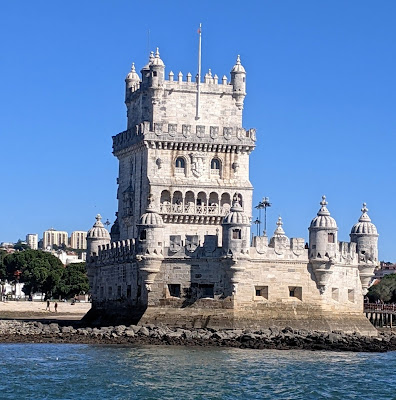 |
| Tower of Belem |
 |
| Monastery of the Hieronymites (Jeronimos Monastery) |
Before the streetlights come on, the restaurants bring out even more tables and everybody seems to be eating and drinking. Unlike in Spain, where no right-minded person would even start to think about la ceña before 10 p.m., dinner starts as early as 7 p.m. in Lisbon, and by the time the Spaniards are just starting their appetizers most places here are beginning to wind things down. As far as the food is concerned, it's hard to go wrong: Seafood and meat are on every menu, and everything is fresh and tasty. I stayed with the seafood and had my share of grilled octopus, salmon, dorade, anchovies, and grilled sardines, accompanied either by a bottle of red wine or a very cold bottle of the young vinho verde, or green wine, that is slightly sparkly, low in alcohol (9% to 10%), and reminiscent of a very dry German Riesling. Round it all out with a nice glass of sweet port, and the eBike ride back to the apartment is guaranteed pain free!
One Portuguese delicacy that is a true must, even for somebody like me who is not much into sweets and desserts, is the nata, a custard-filled pastry that is served hot out of the oven. Pair it with either an espresso (as I did in the swank A Brasileira) or a glass of port (as I did at the more moderately priced Fabrica da Nata) and you will think you've caught a glimpse of heaven.
But a man can't live on natas alone, right? Well, let me tell you, Lisbon has a fairly active craft beer scene. I managed to hit nine microbreweries (one short of my 400th brewpub), and two of them really stood out, 8a Graça and Quimera. The latter took my vote for (tied) Best Beer of the Trip with their Double IPA and their NAFIPA, two fabulous India Pale Ales. Add to that the ambience of being located in a historic tunnel that was once used to take horses into the royal palace—plus an amazing salmon bruschetta as well as super-friendly local owners—and you have the perfect brewpub. But really, all the others were well worth my visit.
But a man can't live on natas alone, right? Well, let me tell you, Lisbon has a fairly active craft beer scene. I managed to hit nine microbreweries (one short of my 400th brewpub), and two of them really stood out, 8a Graça and Quimera. The latter took my vote for (tied) Best Beer of the Trip with their Double IPA and their NAFIPA, two fabulous India Pale Ales. Add to that the ambience of being located in a historic tunnel that was once used to take horses into the royal palace—plus an amazing salmon bruschetta as well as super-friendly local owners—and you have the perfect brewpub. But really, all the others were well worth my visit.
As if exploring the city's alleys, terraços, and squares wasn't enough, I decided on a whim to book a two-hour sailboat excursion on the Tejo to see the city from the water. I found an outfitter via the GetMyGuide app that promised a small-group experience starting at the marina next to the Padrão dos Descobrimentos.
Grizzled skipper Louis and his mate, Fernando, took good care of their seven guests and gave just enough personalized commentary on their 32-foot boat to make this an entertaining and informative trip. It certainly was well worth the €30 to see the Belem Tower, the truly impressive Ponte de 25 Abril, and the Castelo de São Jorge above the center of the city from the water. There were the towering statue of Rei Cristo (which is just a few feet shorter than the one in Rio de Janeiro), and the expansive Praça do Comercio with its arch. I had seen all those sites from a different angle, and this new perspective put yet another spin on this fascinating city. Fernando kept filling our paper cups with vinho verde, and the day got off to a great start!
After enjoying the sailboat tour I decided to take the public ferry to the other side of the Tejo to explore the tiny fishing village of Porto Brandão. For half an hour I walked its few streets and then had a late lunch in one of the two restaurants. I had a huge pot of açorda alentejana, a type of bread and egg stew with shrimp—lots of shrimp! OMG, that and another half bottle of wine damn near did me in.
Another excursion that I booked with GetMyGuide was a full-day excursion to Sintra and the westernmost point of mainland Europe, Cabo da Roca. I had seen photos of the Palace de Pena in Sintra before, but nothing can prepare you for the loud colors, extravagant design, and sheer impossible location of this former monastery that was later turned into a royal palace. Walt Disney meets Legoworld, and you look at it and think, "This can't be real." But it is.
Just a short drive down the road is the equally incomprehensible Quinta de Regaleira, the playground and money-pit of mason Antonio Augusto Carvalho, who created a complex of gardens, tunnels, and whimsical structures that simply has to be seen to be (somewhat) understood. The Quinta has been awarded recognition and protection as yet another UNESCO World Heritage Site.
Overlooking what the medieval Portuguese called the End of the World, with its incessant Atlantic rollers breaking on the rocks below the cape, was another highlight of this trip. The wind was strong, and the view made me think about how much it would have sucked to shipwreck here. The day ended with a late lunch in the pretty town of Cascais, located at the end of the rail-line that leads west from Lisbon.
That final stop in Cascais generated a thought in me: what about taking the train the next day to the final stop of the line and then walk a few miles back along the coast? It was the warmest day of the entire trip, which was a good thing as the waters of the immense Tejo estuary are cold and wild. The Atlantic still has a lot of force, yet the river softens the worst of the swells. Nevertheless, there are surfing spots all along the concrete boardwalk that I took from Cascais to São Pedro de Estoril. The views of beach, water, and coastline were breathtaking, and my early dinner right on the water had the most spectacular setting possible. That excursion cost me €6 in transportation and another €23 for the food and the bottle of wine.
As mentioned in the opening paragraphs, my departure from Lisbon was delayed by 48 hours thanks to an airtraffic-crippling ice storm in Dallas. In those two days I visited the MAAT (Museum of Art, Architecture and Technology), the Océanario de Lisboa, and the Museu Nacional do Alejuzela. It would have been sad to have missed any one of them, just as it would have been sad to miss this tiny bar where two glasses of wine and a shot of ginjinha (made of sour cherries) set me back a whopping two euros and a few cents!
The MAAT consist of two separate entities that in their architecture couldn't be any more different. One is a huge brick building with four large chimneys dating back more than 100 years; it houses the leftovers of Lisbon's old coal-fire-driven electric power station, with its machinery still intact and repurposed as the technology museum. The other part is a shell-like wing of a structure that houses a light installation of immense proportions. No use in trying to try describing the various installations. Suffice it to say that they were mesmerizing.
 |
| One can walk on top of the roof of the new part of the MAAT |
Had I missed the National Tile Museum, it would have meant a huge omission in my visit to Lisbon. I had thought it would simply recount the history of tiles as a majority of the buildings in the historic parts of the city have either completely tiled facades or at least some tile accents. But the museu is much more: Certainly, the building, which is housed in an old convent and monastery and incorporates an ornate church, is adorned with antique tile ashlars. But there are much more recent "paintings" in tile—abstract, pictorially modern, decorative, in portray form, as well as depicting what Lisbon looked like before the great earthquake of 1755, in a 23-meter panoramic tile azulejo that will blow you away!
 |
| No kidding! (It was a gift by the Walt Disney Corporation.) |
There was so much more that I saw, not the most curious of which was the Santa Justa Lift, an iron structure in the style of the Eiffel tower some 150 feet tall that continues to be used to take pedestrians from the lower level of the Baixa district's streets to the Carmo square. It's an elevator, just as those funky trams are called elevators and as there are elevators in houses that have the same purpose.
But I didn't necessarily have to look up to be awed: Many, if not most, sidewalks and essentially all plazas have mosaic-like designs that showcase the local stone masons' skill and the pride for their art. Details are everywhere, and all you have to do is look.
This has been a long blogpost, and not many of my readers will have read all the text but maybe just have scrolled through the pictures. That's understandable. It took me eight full days to see all that I have tried to describe, and I am still decompressing in my dreams, four days after returning. I can only recommend experiencing all these wonderful sights yourself. Go to Lisbon, if you can. You will love it!







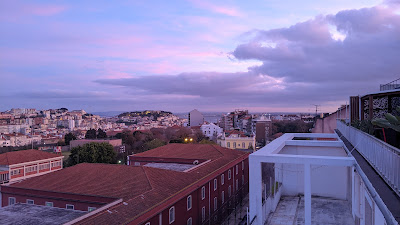











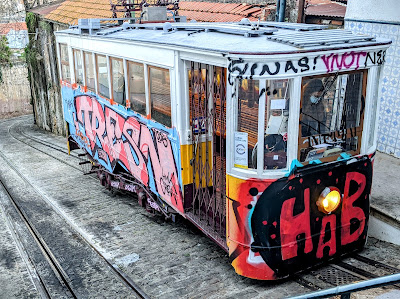




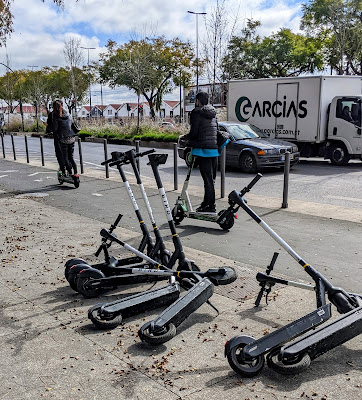




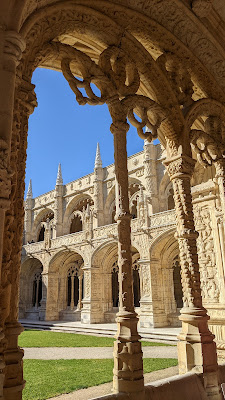



























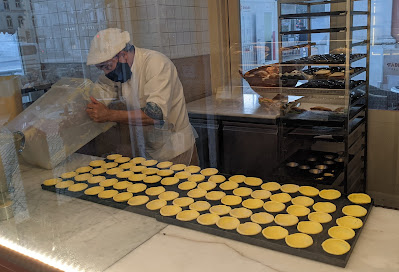












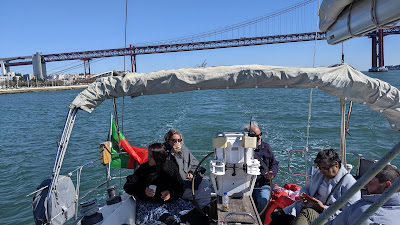













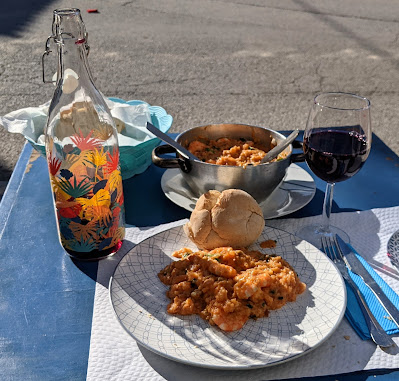










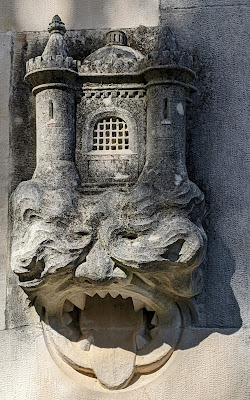
















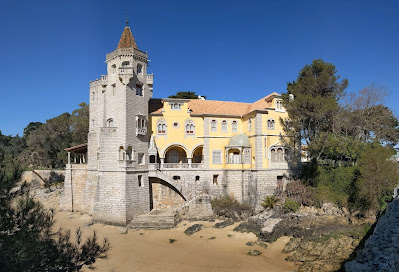



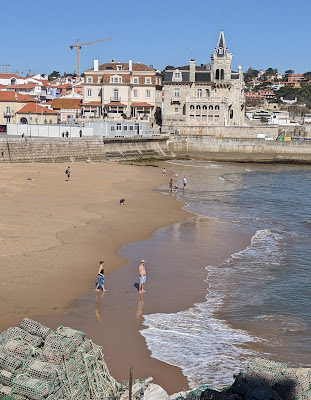
























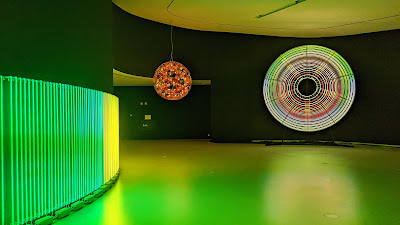





























No comments:
Post a Comment